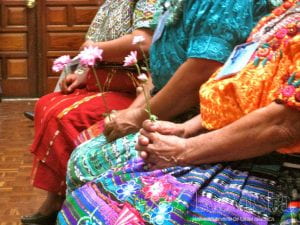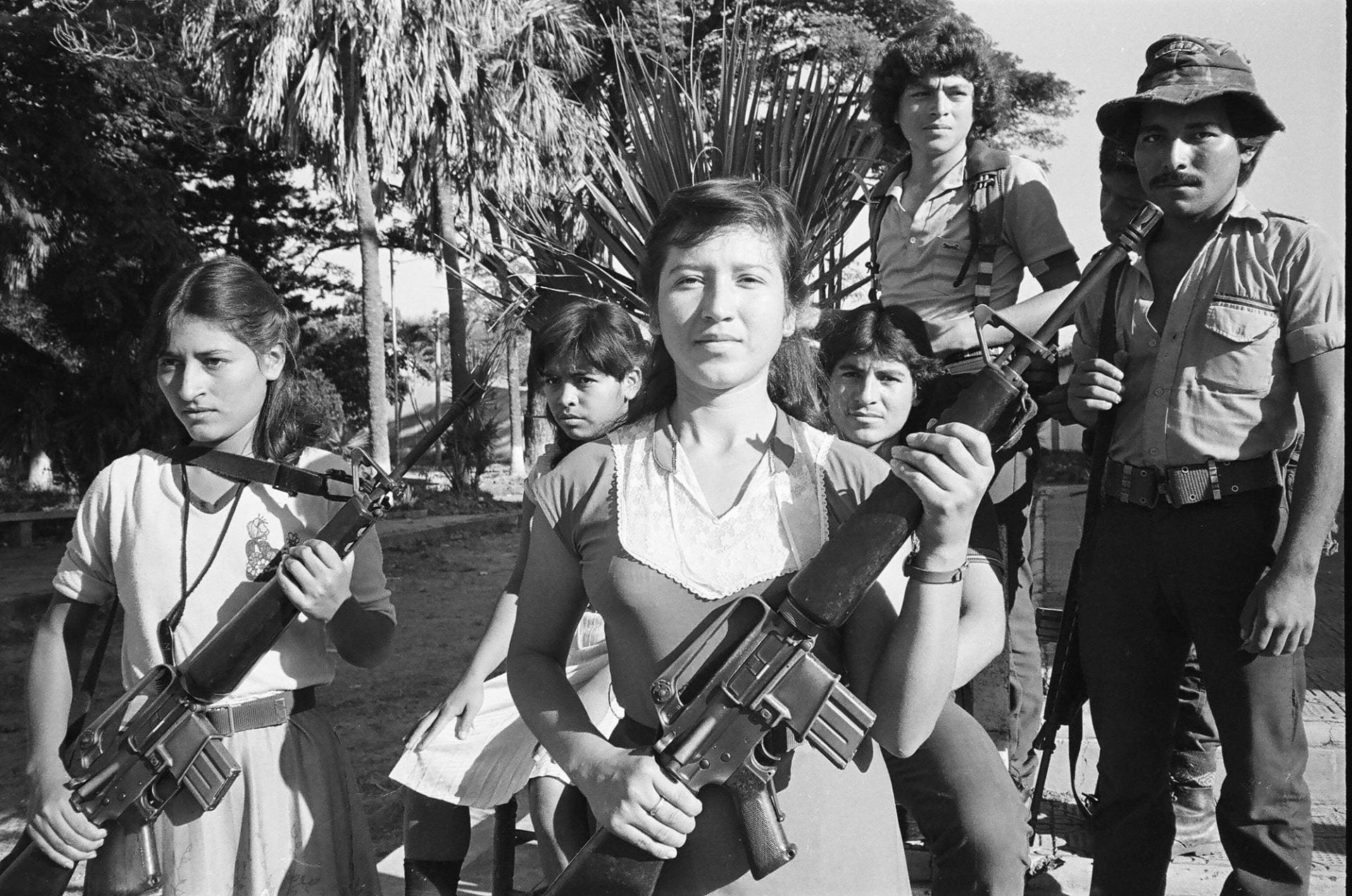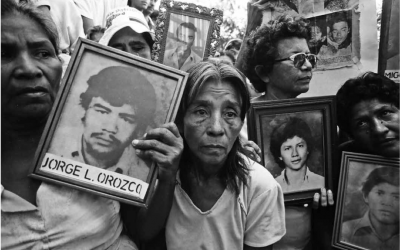Educating the “Good Citizen”
Memory in postwar Guatemala

Ixil women sit in their traditional clothes and hold flowers during the Efrain Rios Montt trial in Guatemala. Photo by Mary Jo McConahay
On my many field trips, I tell Guatemalan teens I’m interested in how they learn about the 36-year conflicto armado (armed conflict). I then study their faces. If not baffled, they avert their eyes and share refrains passed on by many adults in their lives: “We have no historical memory,” or “In Guatemala, there is no historical consciousness.” School teachers say, occasionally with concern, “We don’t talk about that here,” or with more worry, “Young people don’t care about the past. There are too many problems today.”
Guatemalan youth are equally pessimistic about their lack of educational opportunities. They shake their heads and tell me, “Our education here is the worst.” With sunken eyes, they describe how education has become privatized, exclusionary, and yet remains mediocre.
Youth perceptions of Guatemala’s deficiencies are intertwined with their impressions of the unresolved past and the way a history of violence resonates in democracy’s failures. There is a long list of what Guatemala lacks.
Collectively acknowledging historical injustice is central to the project of transitioning democracies. But the violent past is not easily examined in “postwar” Guatemala, where contemporary crime seems to eclipse decades of military brutality, even while today’s political repression of popular movements echoes and entangles past and present violence.
The past is indeed taught in the schools, but for many survivors its moral and political erasures are so substantial that it is rendered invisible. Social studies curriculum in Guatemala relies heavily on two narrative “templates” for interpreting the conflicto armado. The first presents an account of a war that erupted between “two devils,” the state and guerrilla armies. Presumably developed as “compromise” narrative in other Latin American countries contending with their own histories of state repression, the portrayal of mass violence taking place between “two devils” (or “two fires”) functions as a significant equalizer of accountability. Rather than explore asymmetrical power dynamics between the two groups and the particular responsibility borne by the state to uphold human rights under all conditions, conflict between two devils serves to nullify culpability, constructing a net-zero sum. There is no moral accountability or unfulfilled justice; because everyone was accountable, no one is accountable.
The second narrative locates the conflicto armado in a dark past, a tragic event from which Guatemala has recovered in its march toward peace and progress. The horrors of the war have been collectively addressed and swiftly archived, so that they only require a single paragraph in many texts, surrounded by lengthy sections devoted to the peace process, peace values, and human rights principles. Although the war encompassed the “suffering of all Guatemalans,” the conflict was resolved, and today’s Guatemala has learned from its past. The narrative of historical progress conjures the hoped-for but ultimately elusive postwar reality, wherein young citizens ostensibly inherited a peaceful and pluricultural democracy where all people are equal. Importantly, this imagined future requires looking forward toward shared goals, rather than backwards at shared suffering.
Although the national curriculum applies to public and private, urban and rural schools, teachers represent the conflicto armado and its relationship to the current fragile democracy in strikingly diverse ways. Sometimes they take great care to balance the “two devils.” Sometimes they offer subtle or explicit cues that one side was actually more in the right than the other. Teachers themselves have survived the conflict or inherited its legacy; they are invested in its memory or its omission. The inaccessibility of primary historical resources situates testimonio (testimony or witness accounts) as a useful historical source—often the sole source—of historical knowledge. Meanwhile, primary historical sources such as truth commission findings, are almost never discussed in classrooms. Incorporating these accounts chances merging two devils into one.
For the most part, educators, parents, and community leaders face uncertainty about how to teach new generations about the past, when it seems to remain affixed to the present. Interpreting a history of massive human rights violations committed by the state, even when state power changes hands, continues to influence citizens’ attitudes toward democracy, especially when democratic systems are relatively new political arrangements and lack a record of stability. Memories of the violent past are continually accessed, performed, and disputed as citizens make everyday decisions about the nature and level of their civic participation, even while they are uncertain what the war was for. Young people may not know the historical details of this past, but they feel its presence in their lives.
Curricular materials strongly rely on the passive voice, obscuring the agency of historical actors who caused harm, endured suffering, or risked their lives to create a more just society. Erasing the political agency of historical actors, notably the guerrilla, long cast as criminals whose “involvement” threatened national security, creates an impression that little was at stake during the protracted violence. Though the rebel movement’s turn to violence was not without its own excesses, it grew from wide-reaching popular movements, and began with nonviolent demonstrations repressed by an increasingly authoritarian government. The goals that joined diverse people in insurgent movements centered on social justice in the form of social, economic, and cultural rights. Depoliticizing the conflicto armado portrays decades of conflict as yet another bad thing that “just happened” in the succession of colonialism, natural disasters, and the infiltration of the global drug trade. Suffering—whether in extreme poverty, direct combat, or habitual fear of riding the city bus—is conveyed as inevitable, while those who intervene to change the status quo are cast as criminals, killed as martyrs, or become some tormented amalgamation.
What space does this leave for the “good citizen” in a weak democracy, especially when one is situated on the margins? Amidst pervasive refrains that “we learn the past so as not to repeat it,” one of the most salient lessons of the two devils representation seems to be the rigid and autocratic relationship forged between citizens and the state during times of turmoil. The persistence of blame placed on activists today (characterized as agitators and even terrorists) reinforces a myth that loyal citizenship resides in “noninvolvement.” Accordingly, the criminalization of civic action is a strong indicator of an unexamined legacy of the war, one that remains a significant challenge to democracy. Youth themselves are often scapegoated for much that is wrong in the country, blamed for their alleged disregard for the past, absence of moral values, and failure to embrace their roles as citizens in a democracy.
Historical interpretations manifest as civic intentions. While some teachers believe that knowledge of historical injustice comprises essential civic knowledge, others frown upon historical memory as a source of social division and political polarization, and others view discussions of the past as impractical distractions from current challenges facing the country. Good intentions (in most cases) underlie these diverse approaches, but impressions of civic responsibilities remain as polarized as the past itself. Traces of the past and detections of historical continuity breed their own hopes, expectations, and fears about Guatemala’s future, namely, whether it will remain a democracy or return to a military regime. While former head of State General Efraín Rios Montt stood trial for genocide, incipient hopes of justice for the past were couched within everyday concerns over remilitarization. Young people question whether the fact that the current president is himself a former wartime general constitutes a “military government,” and whether there is a legitimate threat to Guatemala’s tenuous peace. Democracy hovers over the list of what we lack.
Despite promises made in the Peace Accords to transform the educational sector, Guatemala’s school system continues to reflect a highly divided and unequal society. These conditions cannot be overlooked when analyzing what young people learn in schools about their civic roles—some seated at modern desks with glossy textbooks and others staring out broken windows and with no books at all. Despite efforts at civic education, Guatemalan youth reveal one of the lowest levels of trust for their government in the Latin American region. In this sense, strong knowledge of democracy’s ideals cannot guard against everyday experience with Guatemala’s democratic failures.
Educational policymakers in the “postwar” years have significantly restructured primary school curriculum and increased access to early childhood education. Current efforts to improve the quality of schools have prompted the Ministry of Education to professionalize teacher preparation, an important step (though highly disputed among teachers-in-training) in transforming the educational sector. Yet amidst these changes, little has been done at the level of secondary schools, where nearly half of Guatemalan youth drop out to pursue jobs in the informal sector, at high risk for criminal pathways. Efforts to revise curricular representations of the conflicto armado are continually “in process,” meet with various forms of opposition, and remain a challenge at the central policy level. The uncertainty about how to move forward permeates all sectors of civil society: is historical memory a hindrance to shared hopes for peace; is its critical acknowledgement central to the postwar future; or has it lost relevance entirely in the post-postwar?
It remains uncertain how Guatemala’s secondary school curriculum will be revised, especially given the ups and downs of the Ríos Montt trial. While the guilty sentence, its overturn, and subsequent uncertainty might significantly alter the historical narrative, it will also undoubtedly breed new counter-narratives and efforts to reclaim the past. “Postwar” generations will determine whether these democratic gaps and historical silences are filled in. The flawed democracy young people inhabit is the one they inherited, with deep and unresolved authoritarian legacies. It is up to them to renew their parents’ dreams for peace and justice.
Related Articles
A Search for Justice
In 2004, when I left Harvard and last saw you, I thought I would never learn the truth of what exactly happened to Carlos Horacio in the horrendous holocaust of the Palace of Justice in Bogotá. Yet fate was holding a tremendous surprise for my daughters and me, filled with…
Memory: Editor’s Letter
Editor's Letter Memory Irma Flaquer’s image as a 22-year-old Guatemalan reporter stares from the pages of a 1960 Time magazine, her eyes blackened by a government mob that didn’t like her feisty stance. She never gave up, fighting with her pen against the long...
A Search for Justice in El Salvador: One Legacy of Ignacio Martín-Baró
In the small rural town of Arcatao, Chalatenango, Rosa Rivera clung to the hope that one day she would find the remains of her disappeared mother and father and lay them to rest in peace. Others sought to exhume mass graves hoping to recover bodies of nearly 1,000 relatives massacred in the Río Sumpul. …




